DIAGRAMS AND MAPS OF THE ACCIDENT SITE
HARD COPY EVICENCE SHOWS THAT THE UTILITY INVOLVED IN COLLISION
WAS TRAVELLING AT 40 TO 50 KILOMETERS PER HOUR WHEN IT BRAKED TO A STOP
AFTER HITTING MY SON
POLICE MAKE OUT THAT ANDREW WAS A HUMAN CANNONBALL IN
THAT HE FLEW THROUGH THE AIR FOR A DISTANCE OF 45 METRES
|
Img044 - Extract from Police Manual
This is a copy of an extract from the Queensland Police Service Traffic Accident Investigation Law and Procedure manual. This was obtained by me under the Freedom of Information Act. The single brake mark from the vehicle's right wheel on the road measured 10.3 meters. According to this chart the utility was traveling just over 40 kilometers per hour when the driver of the vehicle, John Phillips, applied the brakes. This is the same speed that a cyclist could travel at. This evidence was ignored by the police. The police officers said that the vehicle was going at 80 kmph when it hit Andrew. The hard facts show to the contrary - that the driver of the utility was travelling at about 40 kmph when he applied the brakes. The speed limit at the intersection is 60 kmph

|
Img045 - Constable Samantha Johnson's Diagram of the accident site
Constable Samantha Johnson had not marked the collision point between the vehicle and my son on this diagram. Constable Samantha Johnson has not shown the travel path of the utility and of my son as should have been the case according to the Police Manual.
The single brake mark from the vehicle is marked between points 3 and 4. The blood splatter trail is marked between points 5 and 6. The location of the snapped off bicycle's right pedal is located at point 18 in the grassed area at the top of the traffic island. This is well past the inserection area.
The blood splatter and the skid mark are located well past the intersection travelling due west.
The vehicle had been moved from where it had braked to a stop to the location as is marked on the sketch below.
Note: All the trauma is noted on the left side of the road and on the grassed area of the traffic island and the area beyond. There is no trauma in the middle of the intersection. This evidence is corroborated in the police photographs of the accident site
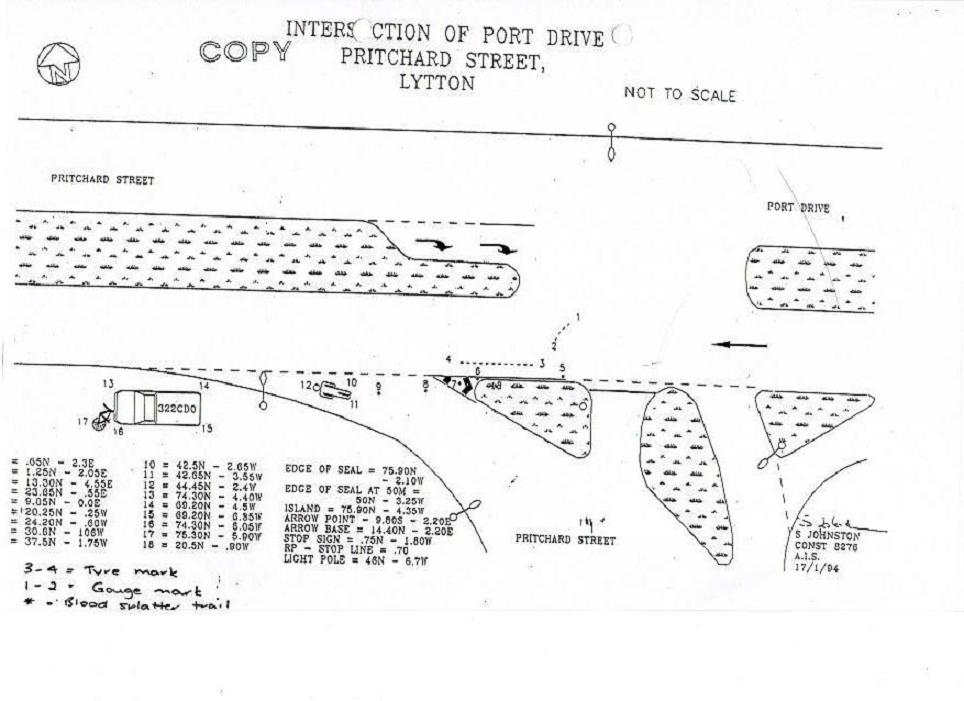
|
Img046 - Constable Samantha Johnson's "To Scale" drawing of the accident site
Constable Samantha Johnson could not transpose all the measurement details onto on her To Scale Diagram. Constable Samantha Johnson was required to do so pursuant to the Queensland Police Service Traffic Accident Investigation Law & Procedure manual. I was told by a number of traffic reconstruction experts that Constable Samantha Johnson's measurements of the accident site were incorrect and could not be deciphered by them.
Constable Samantha Johnson did not show the travel path of the utility and my son after the collision. In the initial to scale diagram Constable Samantha Johnson did not show the collision point. I wrote a letter to her on 8 April 1995, requesting her to mark with an "X" the collision point. As a result of my letter, I got an amended to scale diagram with the collision point marked west to the intersection, next to the curb's edge. My letter dated 8 April 1995, an enlargement of the amended diagram showing the point of collision and a photograph showing the point of collision is noted below.
Constable Samantha Johnson, in a telephone conversation with me prior to the inquest, told me that the vehicle had not run over Andrew. I had told her that her "To Scale" diagram had depicted such an event occurring. I had wanted an answer to my query. Constable Samantha Johnson told me to wait until the inquest for an answer. I never got the answer
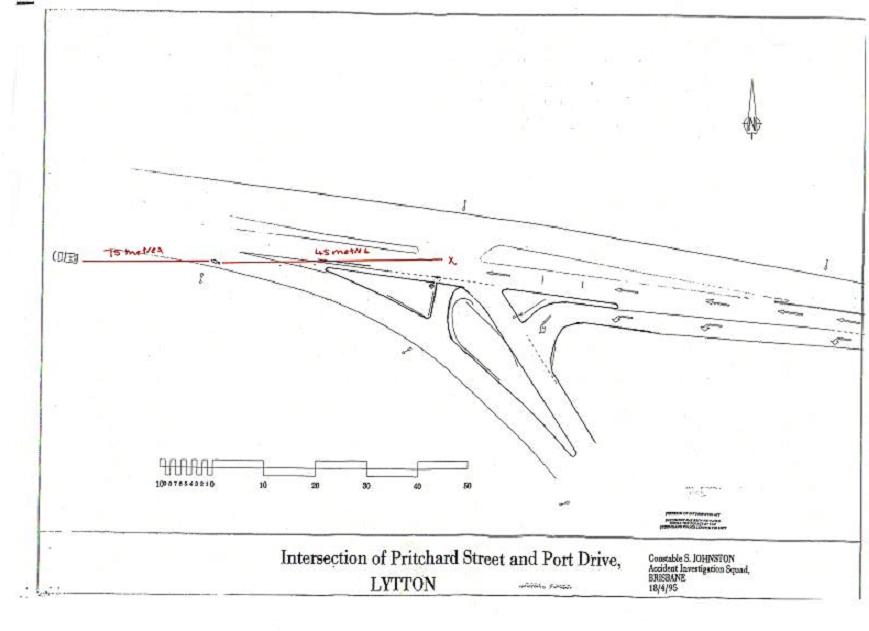
|
Img046(a) - My letter of request to mark collision point of accident
.JPG)
|
Img046(b) - Collision point was marked with an "X" where the "RP" was marked on the road
I got a reply through the Freedom of Information Act. The collision point was marked by Constable Samantha Johnson with a blue X. I then telephoned her. She told me that the "driver of the utility" told her on the night of the accident that is where he had hit Andrew. The Reference Point (RP) is referred on the diagrams from where the measurements were taken which is the actual collision point
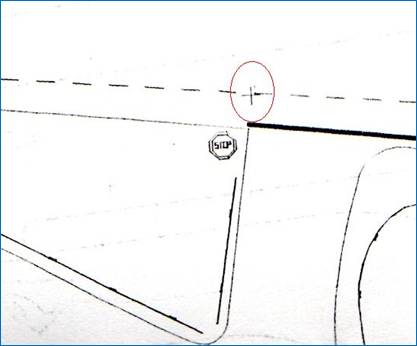
|
Img046(c) - Photograph of the collision point - west of the intersection - RP marked on the road next to the traffic island with the Stop Sign on it
.JPG)
|
Img047(a) - A surveyor's plotted map of the accident site with details
A surveyor, local to the accident site, prepared a survey site map report with the measurements inserted as per Constable Samantha Johnson's measurements as listed in her first diagram Img045. As can be seen points 22 and 23, depicting the large arrow on the road prior to the intersection, are really way out of kilter.
I had asked the surveyor to take it that the wheel span of the vehicle involved in the accident, was 150 centimeters wide. The surveyor was then requested to plot in a red dotted line the actual skid mark on the road of the right tire of the utility (Img003). With a width span of 150 cms a green dotted line was used to mark off the left tire of the vehicle on the grassed area of the traffic island. The left tire of the vehicle had traversed the location, point 18, where Constable Johnson had located the bicycle pedal and in the area where she said that she saw broken glass and bits and pieces of the bicycle in a line. The right tire mark came to a stop close to the liquid “dribble” on the road from the vehicle involved in the collision.
The surveyor had gone to the accident site with his instruments to mark off his measurements. I had sent him Constable Samantha Johnson's sketches and diagrams plus the police photographs of the accident site.
Note: The span width of the front tires of 150 centimeters was taken off the span width of the model vehicle, the same year, type and make as the one involved in the accident
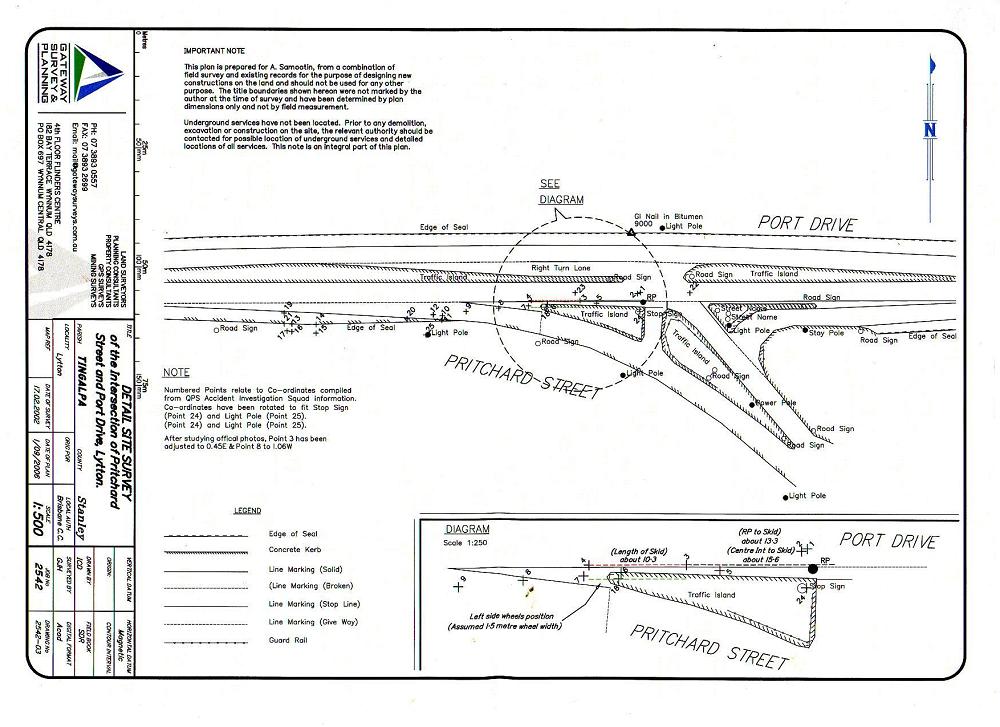
|
Img47(b) Enlargement of the section of the Surveyor's plotted map from above
The enlargement of the small diagram as shown in the diagram above - Img047(a). Point 1 and 2 is the surface scratch mark on the road. RP is the reference point.
Points 3 and 4 mark the single skid mark on the road.
Point 5 is the start of the blood splatter. Point 6 is where there are three drops of blood (presumably it had leaked from the drain holes of the back tray of the utility).
Point 7 is the position of the liquid “dribble” is on the road from the utility. This liquid "dribble" appears to have come from the front portion of the vehicle involved in the accident.
Point 8 is ?
Point 18 is where Constable Johnson had located the bicycle pedal on the grassed area of the traffic island. This is in the same position where Andrew’s blood is. This is the area that Constable Ben Dyball had told me that he and others had placed Andrew on the grassed area when they took him from the rear tray of the utility
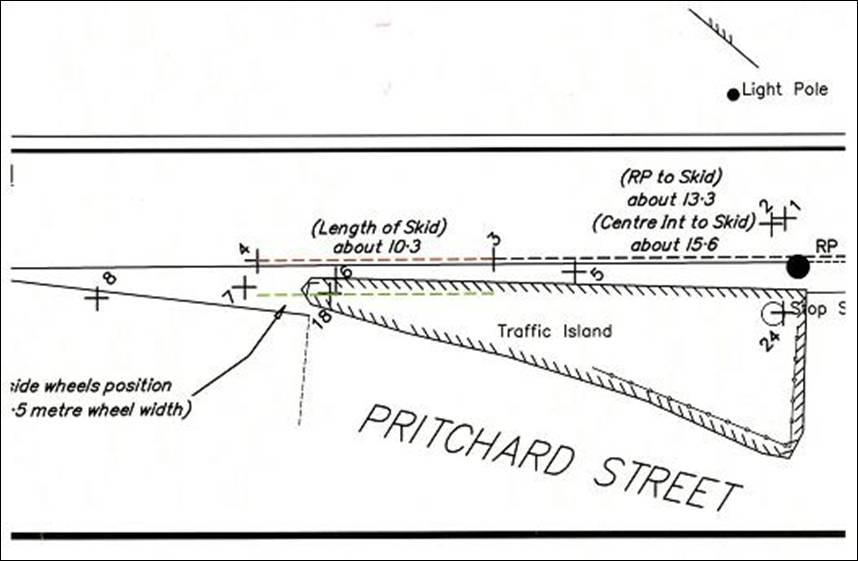
|
Img048, 049 & 050 - Independent Report re speed of vehicle at time of braking on the road
The report states that the vehicle was going at 40 to 45 kilometers per hour and the reaction distance from the stopping point was between 28 to 30 meters
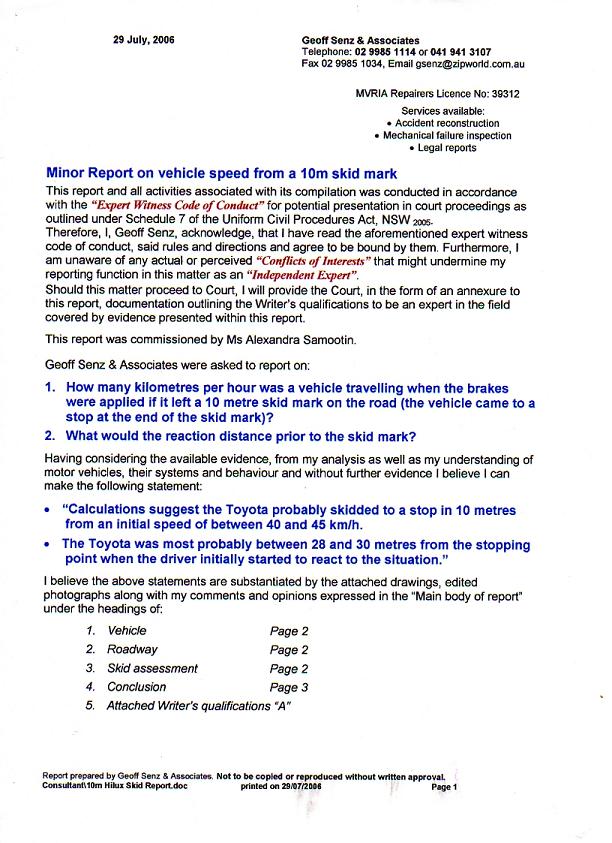
|
Img049 - 2nd page independent report
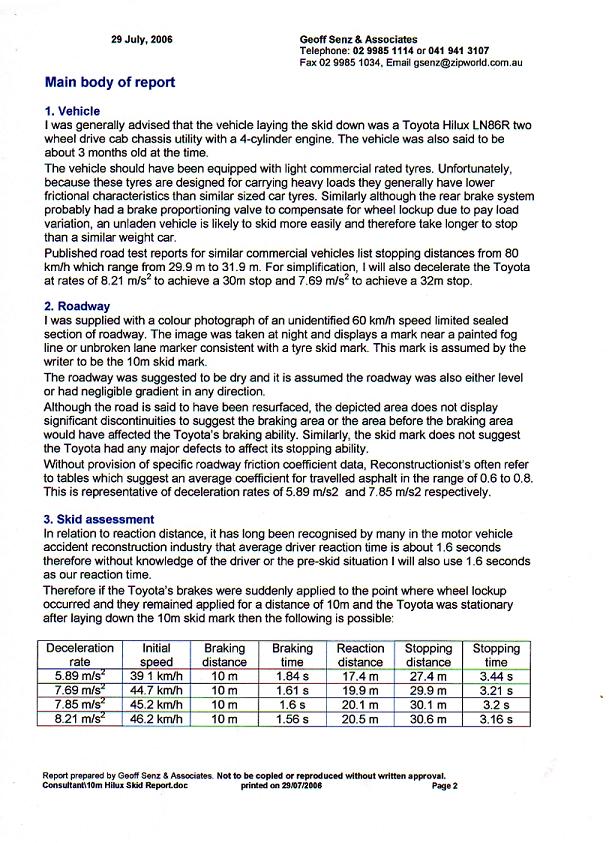
|
Img050 - 3rd page independent report
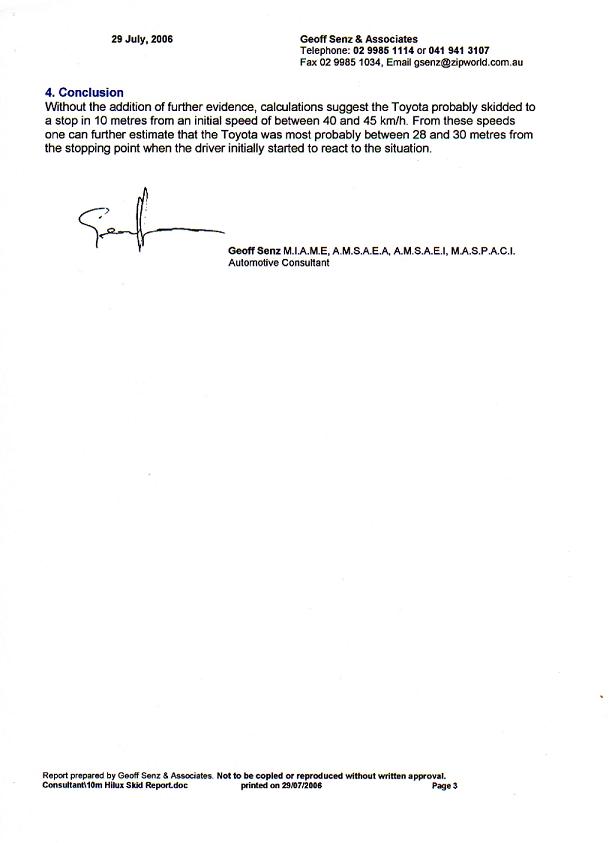
|
Img051(a) - Surveyor's plotting using the collision driver's version of fabricated events
(Note: for greater clarify when the text image is open click on the enlargement tool)
After I received the abovementioned report, I got the surveyor to plot out the reaction distance to braking frame sequence from the driver’s point of view as viewed in the police photograph Img001 and as per his statement in Img052 & 053 - that is, as he was approaching the directional arrow, he saw something coming from his left. John Phillips position at that point in time would have been at the traffic island prior to the intersection. To his "left" was the traffic island with guard rails plus signage, a single lane entrance, plus another little traffic island with guard rails and signage prior to the traffic island with the street/stop sign on it.
Points 22 and 23 depict the arrow prior to the intersection. The measurements of Constable Samantha Johnson had been corrected by the surveyor.
I had asked the surveyor to take it that the utility was traveling in the centre of the road, taking the point of reaction as being 3 meters before the base of the arrow. In Diagram "A", the reaction distance is measured in a blue dotted line and the supposed braking distance is measured with a blue dashed line.
This is the form in which the utility would have left brake marks on the road, taking John Phillip’s’ Police statement into consideration (Img052 & 053 hereunder). Note the position of the scratch mark on the road that is points 1 and 2. On the face of it, it appears that a "someone" had scratched the road surface
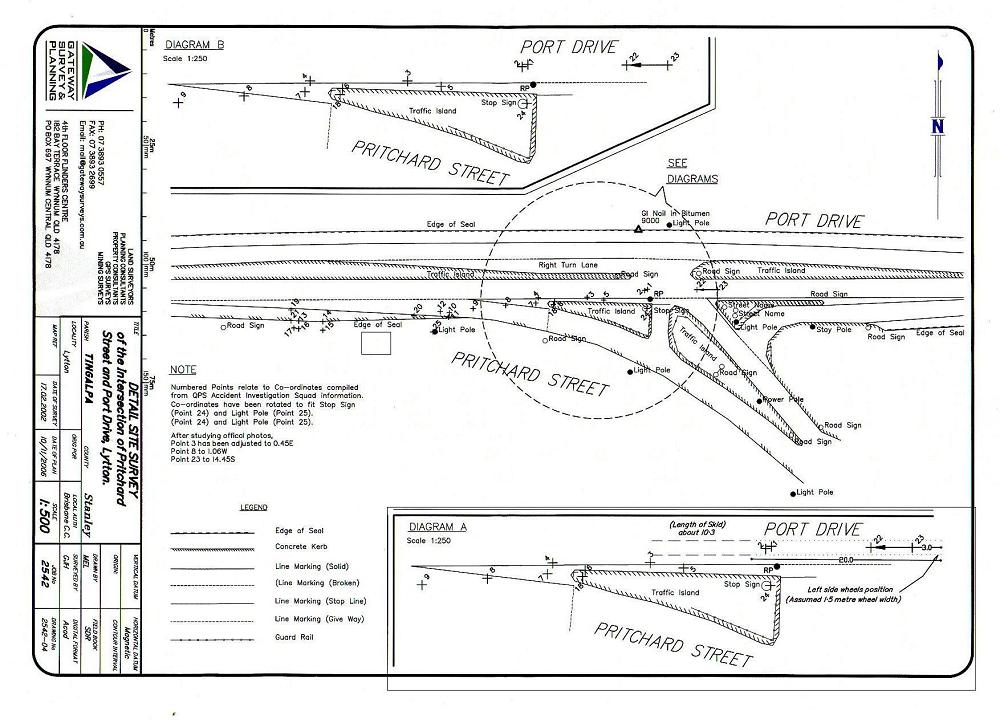
|
Img051(b) - Enlargement of the Diagram "A" of the previous image
The base of the arrow is point 23 and the tip of the arrow is point 22.
John Phillips said in his statement as he was approaching the directional arrow he saw something coming at him from the left. John Phillips' statement is reproduced in Images 52 and 53 below.
Referencing the expert's report in Images 048, 049 and 050 above, the "supposed" reaction distance is marked with a dotted line. The dashed line marks the "supposed" length of a skid mark of about 10.3. The "supposed" length of skid mark on the road stops at a point just prior to the "real" skid mark on the road.
Point 1 and 2 is where the surface scratch mark is. The surface scratch mark is not in the middle of the intersection.
Point 3 is where the single skid mark from the utility’s right tire starts in reality.
Point 5 is where the blood splatter starts in reality.
What John Phillips and the police had said, does not co-relate to reality - embedded facts of the case in the police photographs taken by Sergeant John Ruller and what was told to me by Constable Ben Dyball shortly after the accident occurred
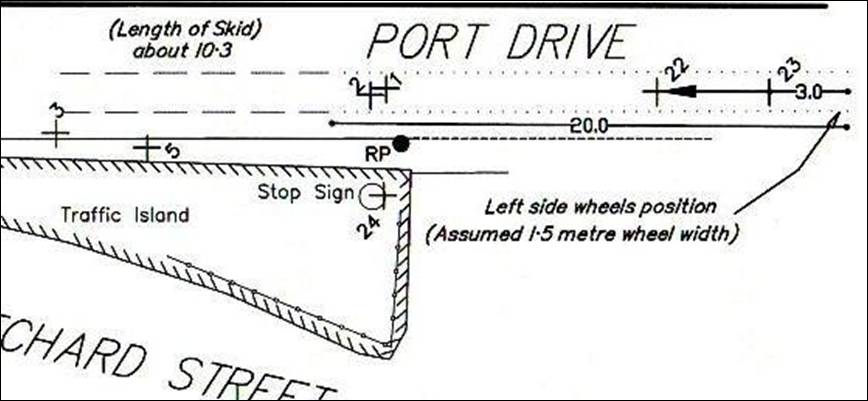
|
Img052 & Img053 - John Phillip's statement - the driver of the utility involved in hitting my son
John Phillip, the driver of the collision vehicle, did not give a statement at the accident site. I was told by Constable Samantha Johnson that he went home and typed up the statement and then had given it to her. It appears on the face of it that John Phillips had written police statements before. It is nicely set out and in proper format. As can be seen by the statement a number of drivers had pulled up behind John Phillips by the time he stopped his vehicle. From an objective point of view (from the man in the street point of view) it could be said that these persons had seen the collision and were close behind John Phillips when he hit my son. I fail to see how one can drive approximately 75 metres in a straight line after glass has flown in one's face with the windscreen and passenger window shattered.
John Phillips did not take the witness stand at the Coronial Inquest
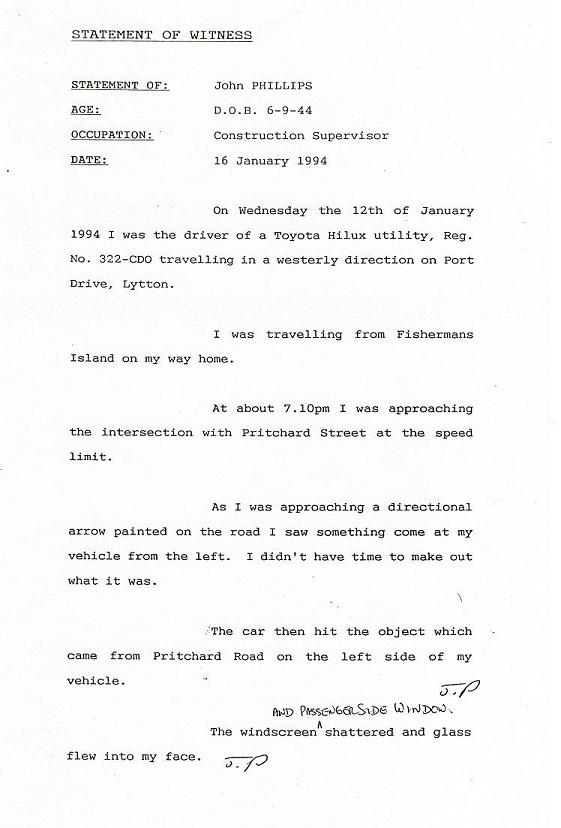
|
Img053 - 2nd page of John Phillip's statement
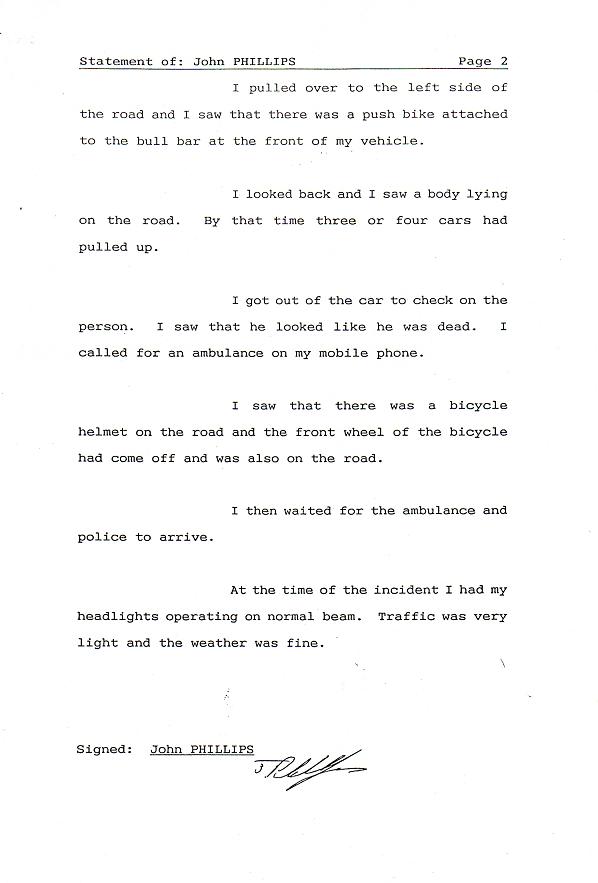
|
Go to top of page |
|